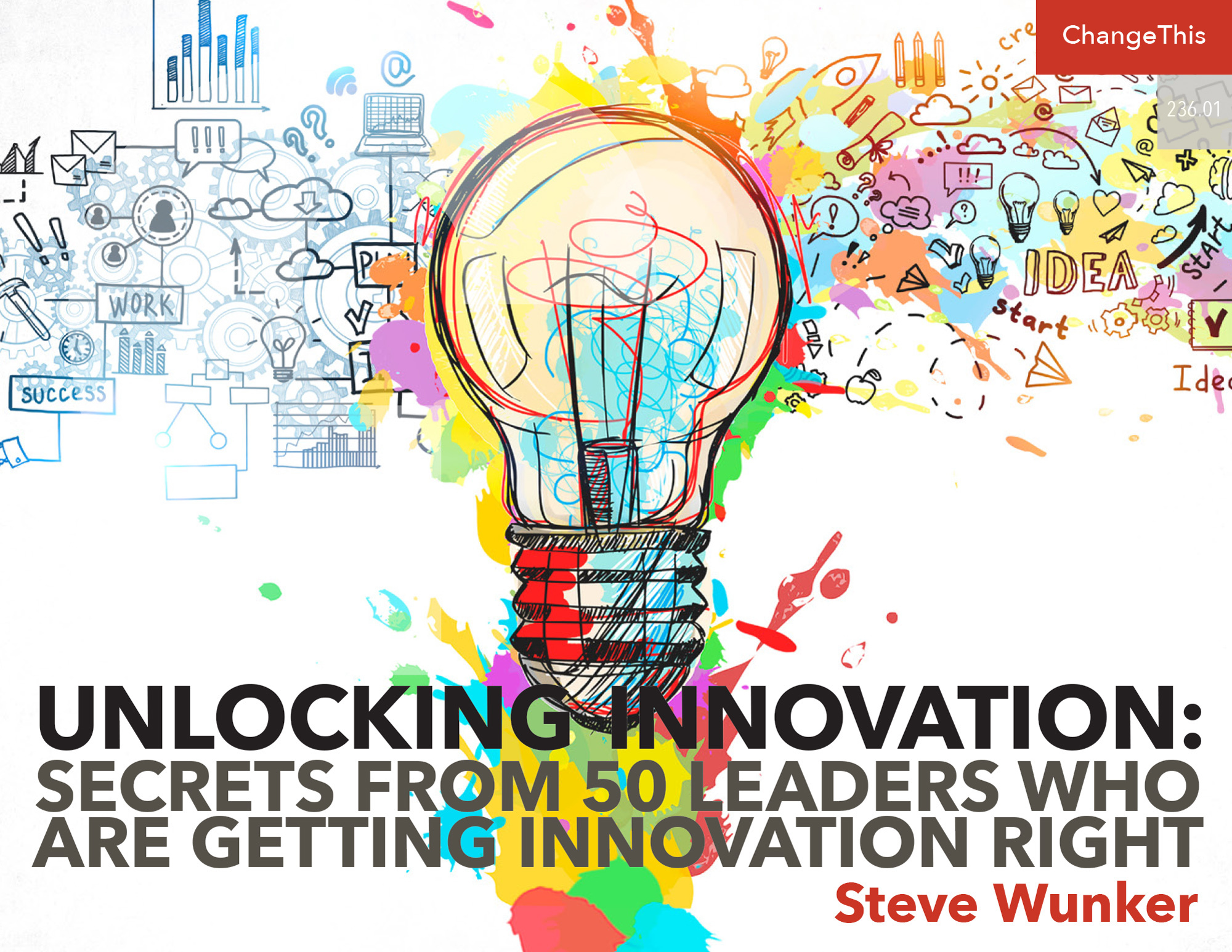Unlocking Innovation: Secrets From 50 Leaders Who Are Getting Innovation Right
Almost every company aims for innovation, yet few hit the mark.
Proof of this fact is all around us: The management consulting firm McKinsey, for instance, found that 84 percent of surveyed executives say innovation is critical for their company’s performance, yet just six percent are satisfied with their results. When the results are so bad, why keep at it?
The world isn’t offering a choice. With the rate of disruptive change accelerating, innovation—alongside its siblings, adaptability and resilience—is essential for long-term success.
Thankfully, we can pinpoint why innovation is such a challenge: it all boils down to where we’re focused. We direct a great deal of our attention toward ideas, yet organizations big and small say they have more ideas than they can handle. In fact, just four percent of corporate innovators say that a dearth of ideas is their biggest problem. The real issue? A lack of innovative leaders who can set a clear agenda for the future, build structures to deal with hard-to-predict events, and foster a culture that brings innovations to life and to market.
We interviewed 50 successful innovative leaders to understand their secrets. These leaders varied in type: from the CEOs of giant companies like Microsoft and Levi’s, to innovation leaders in government and education, to the heads of entrepreneurial startups. There are four practices they all have in common.
First Off, Lead
To start, these leaders had to set the tone and make the hard decisions. But to do so, they had to truly understand their markets to know which direction to lead in. They role-modeled the behaviors they sought—such as keen observation, deep questioning, and constant experimentation—and evolved with changing circumstances. Once they understood their situation, they were decisive, set a clear direction, and then got out of the way so their people could execute.
Just look at what Microsoft’s CEO, Satya Nadella, did. Even though he’d recently led a major change in corporate strategy to emphasize cloud-based offerings, he sought to understand AI’s emerging capabilities and tinkered with early AI products himself. In 2019, he made the radical-seeming move to invest $1 billion in a little startup called OpenAI, and he mandated that the company’s highly diverse business units should pursue AI as a top priority. He then let them go do it, making sure to be there for the tough calls when decisiveness was required.
Set Clear Aspirations
Second, successful innovative leaders set clear aspirations. To them, innovation isn’t an end in itself, adding color to annual reports but not moving the needle in the business. Instead, innovation is linked to important strategic priorities that give management good reason to pursue it.
Innovative leaders set the metrics, timeframes, and guardrails to define what’s in and out of bounds. This is essential; in the same survey where corporate innovators said that ideas weren’t their big challenge, a whopping 56 percent said their largest obstacle was having unclear goals for innovation.
Gary Reblin, Vice President of Innovative Business Technology at the U.S. Postal Service, offered this guidance on communicating these aspirations: “You need to set a solid strategy that everyone can relate to. Make sure people understand why you are innovating. If people don’t understand the need for change, then nothing is going to change.”
Reblin follows his own advice in his communication to employees: “What the Postal Service does—sending out marketing mail—is direct competition to all of digital marketing, from messenger services to social media to Google and Amazon. The Postal Service has to make sure that it competes well in the e-commerce marketplace.”
Build Paths for Big Ideas
Third, innovative leaders build structures so that people can see what customers want—and so that staff can take big ideas forward to commercialization. Companies that struggle with innovation often “shrink” their big ideas to make them easier to agree on and fund. But the real innovators? They play it like venture capitalists. They figure out how to invest just a bit of money into early-stage, raw ideas to test them out. Then, they create mechanisms to double down on the bets that pan out.
Princess Cruises, for instance, tried out a new method for personalizing passenger services in a warehouse designed to simulate a cruise ship deck. Then, it activated the technology, called Ocean Medallion, in the cabins of one test ship. Ultimately, it spent big to roll out the innovation globally, all in the span of a few years.
Cultivate Your Culture Over the Long Term
Many companies seeking to become more innovative immediately jump into trying to change their culture. But the innovative leaders we spoke with recognize that culture lags; you can’t start there. Without the right people in place, or capabilities, or incentives, culture won’t really shift. Once it does, however, innovation develops momentum of its own, and the innovative culture needs to be protected.
Look at what Google does to keep its spark. Google’s managers make an effort to move people who come from well-intentioned but failed initiatives onto projects that are visible and well-known. They aren’t sent to the penalty box; they’re put into the spotlight.
“That’s when I realized that this company was serious about innovation,” said Matt Vokoun, Vice President of Strategy and Business Operations. “Google doesn’t kill individual careers when people work on innovations that don’t work out.”
The Surprising Truth
Rather than emphasizing The Big Idea and individual genius—which is typically celebrated in folklore and film—truly successful innovative leaders invest in something surprising: systems. In an organization, people need systems to deal with emerging technologies and competitive threats, opportunities appearing in new markets, and fast-changing customer needs. Without systems, ideas won’t come from a strategic need and won’t go anywhere.
Create the right leadership style; then it’s as simple as ABC: Aspire, Build, Cultivate. That’s how innovation gets done.




